

- Letter from Executive Director
- Workshop Offerings for 6th-12th Grade Students
- New Saturday Workshops for Triangle Teens
- High Performance Computing University
- Durham County Supports Computing MATTERS Outreach
- Interactivate News- Mathematics Resources for Grades 3-12
- Shodor's Computer Model to Explore the Spread of Disease
- Invest in Shodor
- Summer Student Programs in Review:
- Congratulations to our Graduates!
- Apprentices' Summer Projects
- Engineers in Training at Sigma Xi and Shodor
- An Intern's Teaching Experience at Shodor
- From Apprentice to Apprentern to Intern
Letter from the Executive Director
This has been a year of great beginnings for Shodor, and we expect the process of growth and renewal will continue for some time to come. As you can read in this edition of InterACTIONS, the work of Shodor staff, interns and apprentices is being felt across the Triangle region, across the nation and even across the globe.
We started the calendar year with new partnership with the National Center for Super-computing Applications (NCSA) at the University of Illinois to support faculty training, student internships and curriculum development for what will be the nation's fastest academic supercomputer. In the spring, we expanded our partnership with Sigma Xi, the scientific research society,and with the Consortium for Computing Sciences in Colleges, with funding from the National Science Foundation through a supplemental grant. In concert with the efforts of many high performance computing (HPC) centers and universities, we rolled out a new design for HPCUniv.org. This summer, we reached historical proportions with a record-breaking number of workshops and largest number of participants including students, teachers and college faculty at locations in the Triangle, NC area and across the country.
As the summer ends, some of our high school apprentices are transitioning into apprenterns where they will continue to learn new skills while earning real wages for the skills they have mastered. Even more apprentices will "graduate" to the role of full fledged interns at Shodor or other organizations. The 21st Century workplace skills that we have taught them will enable them to serve society with their high quality work in science. technology, engineering and mathematics.
One program at Shodor that has been behind the scenes providing training and experience has also graduated two more of its most successful pioneers. For nearly a decade Shodor has hired newly minted associate degree and bachelor degree students, giving them their first full-time professional job. These "post-baccalaureate" staffs manage and lead a number of Shodor projects while also mentoring and teaching interns, apprentices and workshop students. Jonathan Stuart-Moore, who began as a high school intern and continued part-tine as an intern through college, has for the last three years served as Shodor's web-master and a leader of the web development team. He starts in September at UNC-Greensboro in the graduate program in music composition to pursue the other side of his most-imaginative skill set. Ismael Torres, who started as a Shodor intern while taking classes at ECPI, has accepted a new position as McClatchy Interactive, applying the skills honed at Shodor in web programming and design. Both have told me that they will continue --albeit in a limited access role-- to mentor at a distance, and to help where they can. We wish them well as they leave the "nest" and help spread the reputation of Shodor as a place of great beginnings.
As we continue our efforts that are transforming learning through computational thinking, we will need the support of each of you and all of you to build new connections, stregthen our partnerships, secure financial support, and to get the word out that, "Shodor is here to help."
Robert M. Panoff, Ph.D.
Shodor's President & Executive Director
2009/2010 Workshops
for students who like science, math, & computers
Register at http://shodor.org/calendar
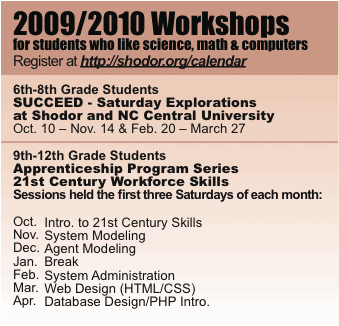
New Opportunities for Triangle Teens
21st Century Workforce Skills Workshops
by Jenny Jones, Shodor Intern
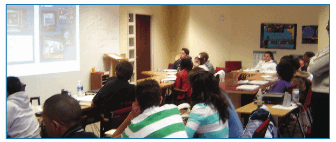
Starting this fall, 9th through 12th grade students can learn the same skills taught to Shodor's Apprentices through 21st Century Workforce Skills Workshops.
This fall, teens across the Triangle will learn technology skills through Shodor's "21st Century Workforce Skills" workshop series. These workshops, once reserved for Shodor's Apprenticeship Program participants, are available to all interested 9th through 12th grade students.
"By offering the workshops as a series, we are allowing students to sign up for the individual topics they are most interested in," explained Apprenticeship Program Coordinator Ernest Edinboro.
Students may also chose the full Apprenticeship Program learning experience by signing up for all workshops in the series at a discounted rate.
A Monthly Series
Each month, students will have the opportunity to explore a specific topic over three consecutive Saturday sessions and will receive a certificate to denote the successful completion of each workshop.
Workshop titles include Defining 21st Century Workforce Skills, System Modeling, Agent Modeling, System Administration, Web Design, and Database Design. Further information is available at http://www.shodor.org/calandar.
"I'm excited that we're able to give more students the opportunity to learn these skills," said Edinboro.
Shodor's goal in offering these workshops is to help students to progress from excitement to experience to expertise in their exploration of mathematics, technology and sciences.
More Workshops for Middle and High School Students
The 21st Century Workforce Skills workshop series is the newest addition to Shodor's offerings for local high school students, building on the success of the Apprenticeship Program. Shodor will continue its SUCCEED Saturday Explorations for middle school students this fall.
For more information and online registration for all of Shodor's student workshops, visit http://www.shodor.org/calandar or call (919) 530-1911.
Apprenticeship Program
A History of Success
Since 2005, Shodor has taught 21st Century Workforce Skills to teens form across the Triangle region through its Apprenticeship Program, providing a unique learning opportunity for students willing to accept a two-year commitment.
Patricia Jacobs, associate director of Shodor, acknowledges the program's success: "Our Apprenticeship Program has reached over 100 student, and we have seen the students gain skills in technology, science and math that prepare them for internships at Shodor or local companies."
For more information about all of Shodor's student programs, visit http://www.shodor.org/students/programs.
High Performance Computing University
( http://www.HPCUniv.org)
by Alex Revelle, Shodor Intern

Today, many problems in science can be solved only with the help of supercomputers. Supercomputers are known for their speed of calculation and their processing capacity, and are commonly used for high-powered modeling, simulation and visualization. High-performance computing (HPC) is what takes place when supercomputers and computer clusters are used to solve advanced computation problems.
Researchers, educators and students in HPC need to understand how to utilize these powerful computers effectively. To this end, Shodor has partnered with TeraGrid ( http://www.teragrid.org) to create the High-Performance Computing University (HPCU). TeraGrid is a collaborative project funded by the National Science Foundation providing the basic, underlying framework to integrate high-performance computers, data resources and tools, and high-end experimental facilities around the country.
HPCU is a virtual organization whose purpose is to share educational training materials and resources in HPC and to help people in HPC understand how to make effective use of these computers. The HPCU portal at http://www.hpcuniv.org provides a plethora of references and curriculum materials, tutorials, events, news items and challenge questions related to HPC.
HPCU also contains a section that focuses solely on students. This special section includes weekly challenges and competitions dealing with HPC and available internships with projects such as Blue Waters and TeraGrid. When Blue Waters comes online in 2011, it is expected to be the most powerful supercomputer in the world for open scientific research.
So, what is Shodor's connection with HPCU? Shodor is not only a partner and contributor to the plans for HPCU, but also has interns and staff who help design and maintain the HPCU web portal. Shodor is also involved in workshop training and material development related to HPC. Additionally,Shodor plays an important role in the education program of "SC," the largest international conference on high performance computing and communications. From SC01, held in 2001, through this year's SC09 and beyond, Shodor staff and students teach and support workshops focusing on computational science and supercomputing.
HPCU web portal founder Scott Lathrop is the Director of Education, Outreach, Training and External Relations for TeraGrid. "The long-term goal of the site and TeraGrid is to reach international organizations and to grow globally," said Lathrop.
According to Lathrop, Shodor's massive database of resources in the Computational Science Education Reference Desk (CSERD) ( http://www.shodor.org/refdesk/) has played a vital role in creating the HPCU website. He credited the "fantastic team at Shodor" for all their assistance in designing and developing the portal.
Shodor hopes to take material in CSERD that is related to HPC and eventually add it to the HPCU site. Lathrop says that the reason for all of this is to help people become more aware of HPC and to cover the whole spectrum of computational science. Shodor is a strong advocate of HPC and encourages anyone who is interested in HPC to view the HPCU website for more information.
Durham County Supports Shodor's Outreach Program
by Jasmine Foust, Shodor Intern
For the past fifteen years, Shodor has been reaching our to the community to "excite" students' interest in science, technology and mathematics. In July, Shodor received funding for its Computing MATTERS (Mentoring Apprentice Transitions Through Experience, Research and Service) program. This grant from Durham County's Non-profit Agency Funding Program (NAFP) was approved by the Board of Commissioners to continue Shodor's local outreach efforts. Computing MATTERS will provide hands-on activities and computational explorations in science, technology and mathematics for local after-school programs at schools and community centers.
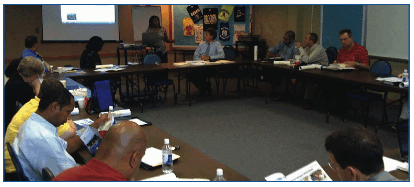
On July 29th, Shodor's Associate Director, Patricia Jacobs and Interactivate Manager, Bethany Hudnutt, spoke to Durham Public Schools principals. Jacobs (pictured) is introducing them to Shodor's online resources and sharing plans to incorporate the resources into the after school programs in some east Durham schools.
In the fall, Shodor will provide computational science workshops as a part of the Y.E. Smith Elementary extended day program and the W.D Hill Community Center after school program.
Dr. Robert M. Pannoff, Shodor's founder and executive director, comments, "We are grateful to the Commissioners for their support that enables us to bring our hands-on and computing approaches to science and math into the county at schools, community centers and faith-based organizations."
Funding from Durham County, along with matching funds from other organizations, and the National Science Foundation, will allow Shodor to build upon the success of the Computing MATTERS program, and expand to include other locations in Durham. As a part of this program, Shodor trains local high school and college interns to teach Shodor's interactive computing explorations at existing after-school and summer programs within local schools and community centers. Along with training students, Shodor will provide training for Durham Public School teachers who are leading or assisting the after school programs at the participating locations.
Alex Revelle, a Shodor intern and rising senior at Durham School of the Arts, teaches workshops at W.D. Hill Community Center. "I have had a great experience teaching the kids," reflects Revelle, "I enjoy it a lot and they enjoy it even more."
Through Computing MATTERS, Shodor will help elementary and middle school students build and sustain an interest in science, mathematics and technology through their high school years, and help high school students to see themselves being successful and happy pursuing studies in college and careers in Science, Technology, Engineering and Math (STEM) areas.
The core goal of Computing MATTERS is to provide a variety of activities ad explorations to excite and broaden participation of underrepresented K-12th grade youth, in science, math and technology careers.
This program will increase computer skills for young students and provide opportunities to explore math and science in a way that is not normally available to them. This program will benefit motivated students with novice skills in computing, especially young women and underrepresented minorities, encouraging them to excel in science, technology, engineering, and mathematics through research experiences and service learning in computational science education.
Together, on-site teachers and trained Shodor interns and staff will provide opportunities to enrich the after school and extended school day programs.
Interactivate News
by Selene Schmittling, Shodor Intern
Interactivate 3.0 Goes Live
The latest version of Interactivate is live! This upgrade incorporated major changes that will allow updates to the activities to be available on an "as released" basis. Previously, the Interactivate team had to update the entire site to make changes, so updates were limited to twice a year. As a result of this new infrastructure, users will have access to new applets and features, along with edits and bug fixes, as they become available.For the July 16th release, Shodor also added many new lessons, discussions and alignments to new standards. To see a complete list, go to http://www.shodor.org/interactivate/whatsnew/.
InteractivatePlus Seeking Schools and Classes for Beta Testing
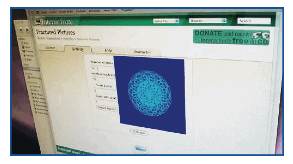
InteractivatePlus, a student progress-tracking tool, is scheduled to be released for beta-testing this fall. This subscription service will allow teachers and/or students to track their progress using the assessment activities. These include over fifty Interactivate activities listed at http://www.shodor.org/interactivate/assessments. InteractivatePlus users will be able to keep track of their progress on a wide variety of math topics over time when they use any of these activities. Likewise, teachers and schools will be able to view student progress in these areas or compare results before and after lessons on these topics. Subscriptions will be available to teachers, students and schools including home schools. Pricing will vary based on the size of the subscription. Individual users, teachers, schools will be able to see the data organized in a variety of different ways including topic, question type, difficulty level, and more.
If you are a teacher or administrator interested in being a beta tester or want more information on InteractivatePlus, please contact the project manager, Bethany Hudnutt, at (919) 530-1911 or bhudnutt@shodor.org.
Featured Online Tool
Disease Epidemic Model
Introducing one of Shodor's newest online resources for educators and students:
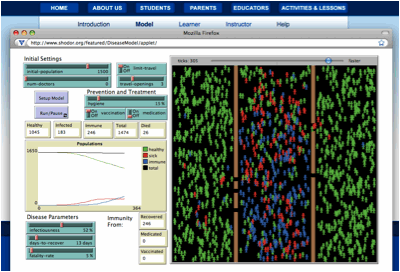
Using Computer Modeling to Understand the Spread of Disease
http://www.shodor.org/featured/DiseaseModel
Disease Epidemic Model is an interactive online education tool that is designed to help teachers and students better understand the spread and treatment of disease.
Providing a balance for the often intense media coverage of the H1N1 Flu (Swine Flu) was one of the chief motivations for Shodor's creation and release of this education resource in May 2009.
Dr. Robert M. Panoff, founder and executive director of Shodor. explained, "This model can help restore "sense and sensibility" into contemporary science lessons as teachers help their students understand what is happening in the world"
The "Disease Epidemic Model" resources include lesson ideas and links to science and math standards for teachers and parents along with suggestions for students' explorations. This and other on-line, interactive resources can be found in Shodor's Computational Science Education Reference Desk (CSERD) http://www.shodor.org/refdesk, a Pathways portal of the National Science Digital Library (NSDL) http://www.nsdl.org.
To browse all of Shodor's online education resources, visit http://www.shodor.org/activities/
Summer Student Programs in Review:
Congratulations to our Graduates!
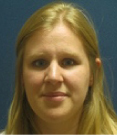
|
Jenny Jones
Graduated from the University of North Carolina at Chapel Hill |
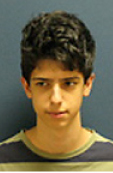
|
Dayyan Borhanian
Graduated from Cedar Ridge High School and will be attending the University of North Carolina at Greensboro |
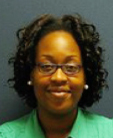
|
Rowena Edwards
Graduated from North Carolina Central University |
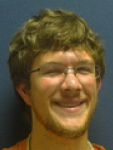
|
Gavin Borg
Graduated from Durham School of the Arts and will be attending Wake Forest University |

|
Sandy Brady
Graduated from Emerson Waldorf High School and will be attending Cornell University |
Training Engineers at Sigma Xi and Shodor
By Cindy Goodson, Shodor Intern

Engineers in Training is one of Shodor's summer workshops traditionally offered to middle school students, but this year there was a twist on the tradition. This summer, Shodor offered an additional Engineers in Training workshop specifically for high school students. In June, Shodor and Sigma Xi, the Scientific Research Society, collaborated to provide a hands-on immersion into the world of engineering for high school students. Then, in July, three Shodor apprentices and I used the curriculum and teaching techniques modeled at Sigma Xi to lead an Engineers in Training workshop for middle school students at Shodor.
A number of exciting experiences set the high school-level workshop apart from its middle school counterpart. First, the workshop was held at the Sigma Xi headquarters in Research Triangle Park and lasted all day instead of three hours. The high school students had the opportunity to learn material above and beyond the basic Engineers in Training curriculum including chemical engineering, biomedical modeling, and a more complex electrical circuit.
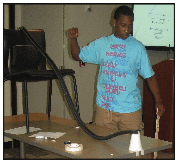
EIT students graphed where a marble landed after rolling down a chute at various heights and then tried to make the marble hit a target.
Also, as a result of the partnership with Sigma Xi, the 12 high school students had the opportunity to interact with an undergraduate, engineering student and engineers in the Triangle area who are members of Sigma Xi.
According to Ada Taylor, Shodor apprentice and student at Sigma Xi workshop, "One of the coolest things about the Sigma Xi workshop was meeting professionals in different fields and seeing how many different things you can study and accomplish as an engineer."
As a Shodor intern this summer, I expected to focus on mathematics education but was excited and a little overwhelmed when I was asked to be the lead instructor for the Engineers in Training workshop for middle school students. The EIT workshop at Sigma Xi gave three Shodor apprentices and me a better understanding of the engineering content, and together we led a successful workshop for 19 middle school students.
Apprentice Krista Katzenmeyer reflects, "Attending the Sigma Xi workshop made it a lot easier to teach the middle school workshop because we were able to listen to someone else teach the material and have a better understanding of what methods worked and what could have been more clear."
The material taught at Sigma Xi impacted the curriculum of the middle school Engineers in Training workshop as well. The exploration-based nature of the workshop made the difficult material accessible to students of a younger age. As a result, I was able to take the complex curriculum and modify it for the middle school workshop without watering it down. This taught me that middle school students can learn very complex concepts when conveyed appropriately. As a future teacher, I will undoubtedly challenge my students with more complex -- but still grade-appropriate -- material in my mathematics classroom.
From Apprentice to Apprentern to Intern
...and From Excitement to Experience to Expertise
By Ada Taylor, Shodor Apprentern
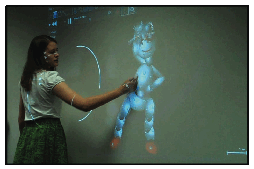
Ada Taylor is demonstrating the interactive whiteboard that she and her team of apprentices built this summer. See page 4 for more information about the project.
The Shodor Apprenticeship Program is a two-year program that teaches high school students a wide range of technology skills, such as HTML, CSS, PHP, MySQL, Java, and more. Apprentices also learn soft skills, such as office ethics, presentation skills, and teamwork. For some participants, becoming an intern at Shodor is the next step to using and further developing the skills they learned through the apprenticeship program.
I have been a Shodor apprentice for the last two years, and this year I was promoted to the title of apprentern. As a result of this promotion, I continued to learn skills through the Apprenticeship Program while also working on some projects as an intern. After becoming an apprentern, I was struck by how much responsibility the interns are given at Shodor, teaching workshops, developing websites, and building and maintaining the web and server infrastructure.
The transition from apprentice to an intern at Shodor is one that a current intern, Gavin Borg, can explain. Gavin started as an apprentice in 2006. A year and a half into the Apprenticeship Program, he was promoted to apprentern, with Shodor staff member Valerie Gartland as his mentor. After taking a leadership role among the apprentices and continuing to learn skills while managing some intern-level projects, he gained experience and confidence. After completing the Apprenticeship Program, he was offered the role of intern with Ismael Torres as his mentor. Gavin has found that intern responsibilities include more than merely using the technical skills developed as an apprentice; it also means teaching others and helping them in the same way that he was helped.
"Half of what I do is helping other people. It's one of the things that I have really enjoyed doing as both an apprentice and an intern," Gavin explained.
For this year's group of apprentices going on to become interns, this means we will have the opportunity to share the skills and material we have learned with next year's apprentices and the younger students in Shodor's SUCCEED workshops. By learning technical skills and putting them into practice in our apprenticeship projects, I believe we are well prepared to become interns at Shodor and other businesses. And after that, who knows? Surely, the many skills we learned as apprentices will come in handy in all of our futures.
My Teaching Experience at Shodor
By Priyanka Baratam, Shodor Intern
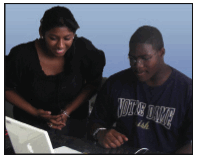
As a Shodor intern, I assisted with two late-summer SUCCEED workshops. These workshops were taught by a team of staff and interns and sparked the interest of the students, boosted their confidence and made learning more fun.
These workshops used current topics relevant to the students to emphasize the importance and applicability of computational science in today's world. Workshops exposed middle school and high school students to technology skills that even many college students are unfamiliar with. Students in many of the workshops learned to model real-life situations using tools such as Agent Sheets, NetLogo, Vensim and Excel.
Forensics
One of the workshops I participated in was a unique middle school workshop exploring aspects of forensics and forensic science. Staff member Kaitrin Wilson and interns Hanley Rice and Rowena Edwards set up a mock criminal investigation for the students to solve throughout the weeklong workshop. Staff member Jeff Krause and intern Selene Schmittling taught sessions on bacterial DNA and forensic toxicology, respectively. In this investigation, I played the role of Priyanka Patel, the Indian news reporter.
The teachers created a crime scene with props such as an encoded note and fake blood to permit practical exposure to the material and make the learning process easier and more exciting. Intern Michael Woody played the "dead" victim as students took photographs and made observations about the crime scene. As the week progressed, they learned about forensic and scientific concepts such as basic cryptography, image processing, fingerprint analysis, bacterial DNA, blood typing, toxicology, and chromatography. On Friday, they used the information they had gathered during the week to come to the conclusion that the victim was accidentally poisoned. They divided into groups and presented their findings to an audience of their peers and to apprentices and staff members. This innovative approach allowed the students to get a feel for what might happen at crime scenes and forensic labs in criminal investigations.
Shodor Scholars Program
A second workshop I helped teach was the Shodor Scholars Program, a two-week intensive workshop for high school students covering multiple topics. This workshop was beneficial to the students as well as to some apprentices and interns like me, who gained teaching experience as instructors.
For the duration of this workshop the staff led the teaching, but the interns demonstrated the construction and use of sample models. I demonstrated biology-based models using both the AgentSheets and NetLogo modeling environments. Toward the end of each day, students were given time to make individual changes to the model they built that day. I was impressed with how well the students understood the programs and that they were able to implement their own ideas into their versions of the model.
Shodor makes a difference in these students' lives and it is good to know that I am a part of that difference. My only wish is that I had attended these workshops when I was younger, as it would have allowed me to familiarize myself with computers and see the importance of computational science at a younger age.
Apprentices' Summer Projects in Review
By Elizabeth Kelley, Shodor Apprentice
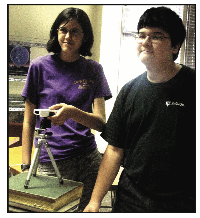
Elizabeth Kelley and Andrew Marron demonstrate their Interactive White Board.
Second-year apprentices worked on a variety of projects over the course of the summer. These projects ranged from database creation to the construction of an interactive whiteboard and involved the use of skills taught during the first year of the apprenticeship program, including: MySQL, PHP, CSS, HTML, and general programming and computing skills.
Converting Interactive to an iPhone Application
Apprentices: Avi Aggarwal, Pablo Heitman, Sidhartha Jandhyala, Mauricio Barreto and Sanket Prabhu
This project involved the conversion of the Interactivate applet "Spinner"into an iPhone application. Apprentices were required to learn a programming language called Objective-C in addition to using the skills that they had already learned in the apprenticeship program. They spent several weeks learning the language before they began actually writing the application.
Databases and Website Construction
Apprentices: Yili Wu, Eric Aiello, Krista Katzenmeyer and Ryan Thuermer
A team of apprentices redesigned the SUCCEED workshop registration system by constructing a database that places application information in a database for easy retrieval instead of sending the data in an email. This allows more than one person to access the data, and prevents cluttered e-mail inboxes.
Another team of apprentices also compiled a database of schools and resources for the deaf, which contained contact information and other necessary or desired information about each resource. This resource will be displayed on the DEAF-STEM website.
Website Redesign Projects
Apprentices: David Keatts, Param Sidhu and Jared Rozenek; Natasha Schwade, Brandon Rochelle, Isabelle Sinclair and Crystyle Caviness; Pamela Valdes, Hun Wong and Ja'beu Henderson
Three teams of apprentices applied the skills they learned during their training through several website redesign projects this summer. One group of apprentices who worked on the Advanced Functions and Modeling website gained valuable experience in MySQL. Apprentices also redesigned the Mentor Center website, which contains information on the Internship Program at Shodor. A third group updated the existing SUCCEED curriculum website, which provides access to materials and lesson plans for Shodor's interactive workshops.
Video Tutorials
Apprentices: Ishaan Puranam, Thomas Fesperman, Zenik Hite, Kyle Morales and Angelina Wu
Apprentices worked on compiling video tutorials of several modeling programs. They first familiarized themselves with each of the modeling programs and constructed the models they were going to demonstrate. They then created videos in which they described the process as it was demonstrated on-screen.
Construction of an Interactive White Board
Apprentices: Elizabeth Kelley, Andrew Marron and Ada Taylor
Apprentices worked on the construction of an interactive whiteboard similar to a SMART Board but controlled by a Wii remote, or Wiimote. This project required a projector, a laptop with the WiiWhiteBoard software installed, a Wiimote, a Wiimote mount, and either a pre-built infrared pen or the materials to build one. The WiiWhiteBoard software is free, and there are versions for both Mac and Windows. When a computer display is projected onto a flat surface, an instructor can use the infrared pen to click somewhere on the display. The infrared flashes from the pen are detected by the Wiimote, which passes the information along to the WiiWhiteBoard software, which in turn tells the computer where to click. Other than the projector, the entire apparatus can be constructed for less than $100.
All of these projects involved either the acquisition of new skills or the use of skills taught during the course of the apprenticeship program.


